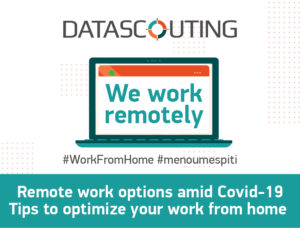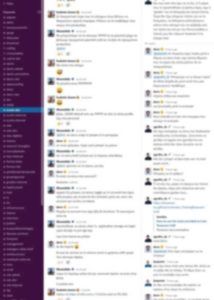Tips to optimize your work from home
by Tom Avramis, our Managing Director
Remote work has become commonplace today as the novel coronavirus continues to spread. For many people it might be the first time they will have to work from home. Size and profession do not matter. The challenge is the same: ensure you remain productive and you protect your employees. And only those doing it in the best possible way will have the right results.
We pride ourselves at DataScouting for being flexible with remote working. And here is how we did it.
Having the right technology to treat it like a real working space
With the spreading of the COVID-19, we began preparations for the entire company to work from remote posts. We broke down the needs of each person, in order to be fully productive. For our company the categories were office space, internet connectivity, computer hardware, software, productivity services.
Office space is not granted for each person but luckily, we had no such issue.
Checking for available physical infrastructure
Internet connectivity was a problem in some cases (low speeds, no landline internet connection) but with the help of the IT hardware department the problems were corrected or alternative means of internet connectivity was provided. For those who had productive specific needs in computer hardware a checklist was compiled for what hardware is available what is necessary (high power GPU acceleration and dual monitor setups for DataScouting, as well as cameras, headsets), and hardware was provided to each, accordingly. In two cases we actually transferred the entire workstation to the remote offices, as that was easier and laptops were not sufficient for productivity.
(Programmers love their hardware)
Testing and software compatibility of the remote workspaces
Simultaneously we tested remote connectivity (x2go) to our office computers via VPN (openvpn) in case remote hardware was not sufficient – we tried to avoid such workarounds due to the lag from remote desktop activities.
Similarly, a checklist of software component needs for productivity was distributed and verified for each and everyone. Since DataScouting is a proponent of open source software that was quite easy, and all proprietary software licenses necessary were purchased as well.
Preventing risks – Staying connected
Finally, tests were conducted to verify that all services used for software development, collaboration and communication was accessible directly. In our case that would include email, file hosting, code repository, collaborative writing, issue tracking, project management, instant messaging, video conferencing. Once again for services not accessible via the internet, VPN connection to the company headquarters was used.
Trial run of remote working
Finally, we decided to do a test run remote working of the entire company for on Thursday (we began preparations on Monday) planned on operations for the entire day, and then return to the office on Friday to see how well it went.
It didn’t.
 (Imagine a cricket stridulating)
(Imagine a cricket stridulating)
Recognizing problems in remote working
The major problems stemmed from the fact that a lot of communication between teams are done verbally, which when translated into instant messaging consumed more time than implementing the subject of discussion. Requests for a video conference call was left unanswered, or would have members waiting for the last one to join in before discussion would begin. More problems arose when joint tests were scheduled and done before all edits to the project were committed or editing the same file at the same time created conflicting documents because one did not see a WIP (work in progress) on the messaging channel. The next day we gathered wondering if remote work was possible.
It was.
Laying down guidelines to overcome communication obstacles
Based on the discussion we had, we adopted a series of rules for interacting. Depending on the medium, scope of communication, urgency and the number of people involved we agreed on ways to work. Morning acknowledgments for being online and available for tasks. (a good morning to all greeting) Instant messaging on project specific channels for coordinating team members. Documenting all task evolutions on our project management software. Using emails for tasks that need reviewing like business management and accounting. Insisting that all clients report problems on our issue tracking platform, and if not possible, reporting the problem ourselves so all relevant parties are informed. Appointing from the start of the day meeting times for teams to communicate via teleconference (usually one or twice daily). For some tasks even a continuous communication channel was maintained to make sure that everybody was working with the same goal in their mind. And more importantly declaring people as points of contact for all company and productivity issues (which means those point of contact will have to consume a lot of time as information mediators – a necessary step in the process, at least in the beginning).
(A snippet of our many many many messaging channels)
Best practices for collaborative work at remote workplaces
We did not only evolve our communications to handle teleworking, but also our working procedures had to be adapted to maximize productivity from remote workplaces. We scaled tasks to 2 to 3 person teams for easier collaboration. We stated documenting new tasks with more rigorous specifications to minimize communications for clarifications. We stated that administrative inquires were to be grouped and answered at intervals to avoid flooding of key personnel (We are sure all of you had had a day that the only thing you did was answer emails)
Unique challenges and solutions for a company on teleworking
We are presenting here a case study of DataScouting’s woes and tribulations on remote working while navigating the changing social environment for each of us. It goes without saying that other companies have to find their on path towards a productive teleworking model. We are pleased of course to discover all of our clients avoided most of the remote working problems due to the automation and procedures our solutions provided the for productivity and collaboration, but that will be a totally different blog post.
Keeping spirits high
Effective remote working teams do not just require the right technology; they require the right leadership. And we would not be happier of our team. Working extra hard to communicate in a level manner, emphasize verbal support and encouragement are more important than ever. Setting real expectations and trusting our employees is very important. Thus, our focus has also changed and we now encourage our team to focus on what they can do with certainty (such as projects that can still happen even in a remote setting). We make sure we provide them vision and direction on the current priorities. And of course, we have an online “party” every Friday, to keep our spirits high.









